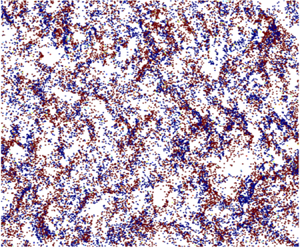 $Re_{\tau }=5186$
$Re_{\tau }=5186$Published online by Cambridge University Press: 09 February 2023

We perform two-way coupled direct numerical simulation of particle-laden flow in an open channel at a friction Reynolds number ( $Re_{\tau }$) of 5186, which exhibits many characteristics of high-Reynolds-number wall-bounded turbulence, such as the distinct separation of scales in the inner and outer layers. Three representative cases, an unladen case and low- and high-Stokes-number particle-laden cases, are performed to investigate the turbulent modification by particles. To this end, we compare several statistical quantities to understand the particle effect on momentum exchange and interphasial energy transfer. The modulation of large-scale motions (LSMs) and very-large-scale motions (VLSMs) are analysed using spectral information, and we find that the LSMs and VLSMs are generally weakened in the inner and outer layers, which is qualitatively different from similar simulations at lower Reynolds numbers (
$Re_{\tau }$) of 5186, which exhibits many characteristics of high-Reynolds-number wall-bounded turbulence, such as the distinct separation of scales in the inner and outer layers. Three representative cases, an unladen case and low- and high-Stokes-number particle-laden cases, are performed to investigate the turbulent modification by particles. To this end, we compare several statistical quantities to understand the particle effect on momentum exchange and interphasial energy transfer. The modulation of large-scale motions (LSMs) and very-large-scale motions (VLSMs) are analysed using spectral information, and we find that the LSMs and VLSMs are generally weakened in the inner and outer layers, which is qualitatively different from similar simulations at lower Reynolds numbers ( $Re_{\tau } \approx 500$). The spatial structures are investigated with correlation analysis, and inclined VLSMs are observed in the near-wall region, with decreased inclination angles by particles. The particles tend to widen and shorten the spanwise and streamwise extent of coherent structures, respectively. Furthermore, we find that the vorticity vector displays a preferential alignment with the eigenvector corresponding to the intermediate eigenvalue of the strain-rate tensor, independent of the particle Stokes number.
$Re_{\tau } \approx 500$). The spatial structures are investigated with correlation analysis, and inclined VLSMs are observed in the near-wall region, with decreased inclination angles by particles. The particles tend to widen and shorten the spanwise and streamwise extent of coherent structures, respectively. Furthermore, we find that the vorticity vector displays a preferential alignment with the eigenvector corresponding to the intermediate eigenvalue of the strain-rate tensor, independent of the particle Stokes number.